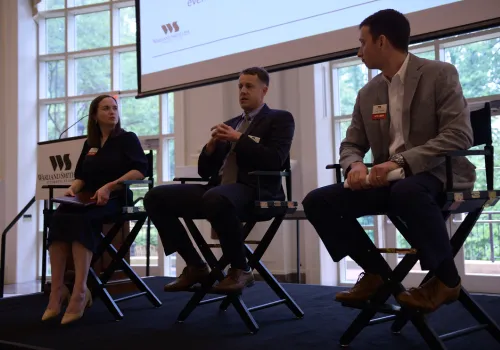
Three Ward and Smith attorneys delivered critical legal updates at the firm’s 2025 Construction Conference, covering evolving employment regulations, North Carolina’s Notice of Contract tool, and the fine print of insurance policies that protect projects and firms from costly pitfalls.
The session was designed to give construction business owners fresh insights for managing risk and staying competitive. Topics included noncompete agreements, new OSHA heat rules, misclassification issues, and overlooked contract protections.

Emily Massey, a North Carolina Board Certified Specialist in Employment Law, said rumors about the demise of noncompete agreements are overblown. “There is currently not a ban on noncompete agreements, but the rules are constantly evolving as far as what is enforceable,” Massey advised. “So if you have a non-solicitation agreement or noncompete agreement in place, you should have it reviewed by legal counsel.”
She added that federal overtime exemption rules continue to shift. “The takeaway is that we recently reverted back to the old rules,” Massey noted. Right now, the minimum salary for exempt status is $684 per week — about $35,568 annually — but job duties must also meet strict tests.
On misclassification, Massey warned that control and supervision are key factors. She also pointed to potential changes if the political landscape shifts: “The Trump administration could potentially seek to modify the overtime rule,” she said.
OSHA’s proposed new rule on heat hazards could reshape jobsite operations in hot states. “Considering the number of blisteringly hot days we have in our state, this could have significant implications,” Massey said. If passed, the rule would require breaks, water, and symptom monitoring once heat indexes cross 80°F, with stricter requirements at 90°F.
Massey also explained the impact of Executive Order 14173, which prohibits illegal DEI policies for federal contractors. “This essentially just says what we always advise our clients, which is: do not engage in illegal discrimination under Title VII,” she said. “What this does not say is that you cannot promote fair and inclusive workplaces.”

Luke Tompkins, commercial litigator, detailed how North Carolina’s Notice of Contract helps general contractors protect against surprise liens. “This is a valuable tool for general contractors, because it can prevent a second or third-tier subcontractor from placing a lien on the project property,” Tompkins said.
The form must be posted on-site and filed with the Clerk of Court within 30 days of the building permit or contract award. It shifts the burden to subcontractors to preserve lien rights properly — a step many GCs overlook at their peril.
Insurance Provisions: Read the Fine Print
Jeff Stoddard, construction litigator, warned that general liability policies often exclude the problems contractors assume are covered. “These policies are very long, and insurance companies are experts at making you think you’re buying a lot of coverage when, in fact, the things most likely to happen to you are excluded,” he said.
He compared specific peril to all-risk policies. “Under all-risk insurance policies, the insurance carrier is liable for all risks, except those specifically excluded,” he noted.
Stoddard stressed that CGL insurance is not a warranty. It may pay for damage caused by faulty work — like water damage from a leaky roof — but won’t pay to fix the defective roof itself. “It is absolutely paramount to note that CGL insurance does not serve as a warranty,” he said.
He urged contractors to clarify coverage with agents, get listed as additional insureds on subcontractors’ policies, and avoid missteps that could void coverage. “Most contractors don’t come to me until after they’ve already submitted something, and by then, it’s harder to help,” he said.
Ward and Smith recommends leaders review agreements with counsel, train field managers on new rules, and talk to insurance brokers to align coverage with real project risks.
Originally reported by Ward and Smith.